Abstract
The number of earth-rock dams and their failures are both the highest of all dam types. For a large number of dangerous situations, multi-angle and multi-level effective safety analysis is urgently required. In this paper, a series of studies on seepage and slope stability of the dangerous clay core dam with danger control and reinforcement (CCDDCR) are investigated by a proposed finite element analysis method. A verification process is finished for this proposed method. A new calculation model is proposed based on an iterative algorithm, and a successful example is then taken on. A reasonable conclusion is given based on the analysis of the three-dimensional finite element model of the dangerous CCDDCR. In view of the conventional concrete, the elastic modulus of the wall is higher, and large deformation and stress and concentration will appear under the water loading, which then affects the anti-seepage effect. Its purpose is to investigate the effect of diaphragm wall material in concrete with low elastic modulus on the anti-seepage wall and its significance in similar reinforcement engineering. The first tentative comparative analysis is taken on by this paper for slope stability analysis between the Lizheng method and FEM method. More useful conclusions can be drawn in future for reference in similar reinforcement projects.
1. Introduction
In recent decades, many problems have arisen with dams due to their age and the use of outdated technology [1,2]. Many dams have fallen into disrepair and, as a result, have faced serious safety problems. Due to a lack of consideration of soil material specificity, earth-rock dams constructed with a low-technology approach have suffered from varying degrees of leakage, cracking, and so on. In order to allow such dangerous earth-rock dams to continue in operation, reinforcement measures are badly needed to restore dam body safety. Therefore, the analysis of reinforcement materials has become an important aspect of the reinforcement process. Concrete, which is widely used in all kinds of structures for its unique material character, was finally selected as a cheap reinforcement material. However, there has been little reinforcement analysis of the clay core with its low-elastic-modulus material [3,4,5]. With conventional concrete, the elastic modulus of the anti-seepage wall is higher under water loading. Large deformations and stress concentrations will occur. Cracks may be generated in the wall by tensile stress, thereby affecting the seepage effect. The importance of a low-elastic-modulus material for such a concrete reinforcement dam project is considered here. Furthermore, by considering different values of the elastic modulus for the anti-seepage wall of a practical project, the effect of low elastic modulus on the anti-seepage wall is studied [6,7,8]. Recently, 3D seepage numerical analyses have been performed, and hydraulic coupling analysis is used for the seepage stability of the dam [9,10]. In addition, it is necessary to consider related research into a number of reinforcement projects concerned with dangerous dams [11,12,13,14].
The research methods for the seepage calculation and analysis of an earth-rock dam mainly include: theoretical solution, physical simulation, and numerical simulation. Among them, the finite element method is one of the most widely used. The finite element method can be used to solve stable seepage and unstable seepage, and the two-dimensional and three-dimensional models can be processed. It can not only face the heterogeneity of the embankment foundation but also conduct research on the anisotropy. Therefore, the existing seepage calculation theory can basically meet the seepage analysis needs of similar embankment projects [15]. For seepage analysis in the case of free surface, it is mainly about the calculation method of the invariant grid, that is, it is studied in the fixed grid. The representative methods are virtual element method, the improved method proposed for three-dimensional problems, nonlinear stress analysis based on the residual flow method with the concept of initial stress, and the proposed initial flow method [16]; Neuman proposed the Galerkin method for fixed grid research, and Desai proposed the residual flow method [10,17].
The commonly used fixed grid methods mainly include: virtual element method, initial flow method, grid correction method, element permeability matrix adjustment method, residual flow method, node virtual flow method, etc.
- (1)
- Virtual element method
The virtual element method is to calculate the intersection point between the free surface and the element boundary line through the node head value obtained in the last calculation and then move some nodes of the element across the free surface to make them fall at the intersection point [18]. The free surface divides the element into a real seepage area and a virtual area. The virtual area of seepage will not be involved in the next finite element calculation, and the calculation area of seepage will continue to approach the real area of seepage, and the result will also approach the true solution. When moving some nodes of the element across the free surface, the elements above the free surface do not participate in forming the penetration matrix. During the iteration process, as the free surface moves up, the iteration cannot continue. Therefore, the virtual element method is used to deal with elements with free surface crossing as the node moving path is difficult.
- (2)
- Initial flow method
When the initial discharge method is used to calculate the initial discharge of nodes crossing the free surface element, the Gaussian points below the free surface will not be calculated. Therefore, the calculation accuracy will be affected [19].
- (3)
- Grid correction method
Firstly, assume the position of the seepage-free surface and then take it as the calculation boundary [20]. When the water head value H of each node is obtained, verify whether the condition is satisfied. When the position of the free surface and the escape point cannot be adjusted, assign the calculated H to the new coordinate Z of the free surface, and then solve. According to this cycle, five or six iterations can obtain satisfactory results.
- (4)
- Element permeability matrix adjustment method
The free surface divides the solution domain into two regions: one is in region A1 above the free surface, where the velocity at each point is zero; the other is in area A2 below the free surface, where each point has a velocity greater than zero. In order to reflect this phenomenon, the real permeability coefficient can be used in A2; on the contrary, the permeability coefficient k is 0 in A1 [21].
1.1. Proposed Calculation Model
1.1.1. Theoretical Model
A nonlinear elastic model is used based on an incremental generalized Hooke’s law. The model embodies a nonlinear relationship between strain and stress. It includes nine material parameters, all of which have specific physical significance and can be easily determined and used in numerical calculations. Duncan and Chang proposed a model for the relationship to obtain the tangent Poisson ratio. The tangent elastic modulus is expressed as:
where c is the cohesion, φ is the friction angle, Rf is the break ratio, K is the magnitude of the initial elastic modulus, and n is the index of elastic modulus, Pa is the atmospheric pressure, K is the principal stress ratio, Ei is the initial elastic modulus, Et is the tangent elastic modulus, σ1 is the large principal stress, and σ3 is the small principal stress.
For a resilient modulus,
where Kur is the unloading modulus. The final expression for the tangent Poisson ratio is:
and
In Equations (3) and (4), G is the initial Poisson ratio and F is the decrease rate of the initial Poisson ratio with the increase of . The parameters G and F can be obtained from triaxial tests, and d is the reciprocal of the incremental value for the assumed axial strain. lg is the logarithm with base 10 (the common logarithm), such as lg 10 = 1.
Thus, there are nine parameters for the model, K, n, Rf, c, φ, F, G, d and Kur, which can be obtained from a conventional triaxial specimen.
The shear strength mode of dam shell filling materials shall be linear. The expression is:
A linear elastic model is adopted for the rigid concrete cutoff walls and bedrock, and its shear strength can be approximately estimated by the following formula:
where is the compressive strength of unconfined pressure, is the flow value and generally taken as 2~3, which is defined as:
tg is the abbreviation of tangent, mathematical trigonometric function.
The stress level of a linear material is defined as:
where: is the uniaxial tensile strength of linear materials.
The contact surface between the cutoff wall and dam material is simulated by Duncan Clough’s hyperbolic contact element model.
The tangent shear stiffness reflecting the relationship between shear stress and relative displacement on the contact surface is:
where: , , , , are shear stress, normal stress, failure ratio, shear strength parameters on the contact surface, and controllable stress respectively. are water unit weight, while and are dimensionless coefficients. As the normal stiffness of the contact element compressed is taken as 108 kPa/m, the smallest value shall be taken during tension.
For the three-dimensional finite element models described above, it is given different material properties. From the results, the effect of the concrete diaphragm wall is very apparent in dilapidated earth-rock dam seepage prevention.
According to Darcy’s seepage law and flow continuity equation, the basic differential equation of stable seepage can be expressed as follows [22]:
The expression of seepage energy in seepage area is [23]:
And both forms of the above two calculation equations are extremely close. It also indicates that consolidating the seepage calculation for the project is feasible.
1.1.2. Proposed Method
Based on the demand for seepage calculation and analysis of earth rock dam engineering with a unique core wall form, the seepage is calculated according to the principle of the virtual point method and is realized based on element birth and death technology. Firstly, the position of the phreatic line is assumed, and the iterative calculation is continued until the difference between the two iterations meets the limit. The phreatic line is analyzed, and the position of the escape point is found. Then, the total seepage flow is calculated.
Under similar boundary conditions, the seepage field can be analyzed through the thermal analysis module; however, it is more appropriate to use the birth and death element technology for the phreatic line problem, which requires secondary development. The seepage of an earth rock dam with a unique core form has a free surface, which is called saturated soil below the free surface and has a fixed permeability coefficient. The part above the free surface is considered not to participate in the seepage calculation. For the definite solution conditions, it is assumed that the normal seepage velocity of the phreatic line is zero. The idea of secondary development is: the position of the phreatic line is assumed, the downstream outlet of the earth rock dam project with a unique core wall form is continuously calculated according to the assumed boundary conditions, and then the tolerance is set. When the difference between the total head calculated twice meets the given tolerance, the calculation result will be obtained.
The calculation of free surface is one of the difficult problems in seepage analysis. The free surface of seepage is the boundary to be determined in the seepage field, which needs to meet both the first and second boundary conditions. In most current fixed grid methods, the calculation of determining the free surface is more complex and highly dependent. This paper proposes to use the local grid change method to analyze the hazard removal and reinforcement project of this unique core wall-type earth-rock dam project. The above method can not only simply change the grid of the old iteration to the grid required after the new iteration, but also use the body-fitted coordinate transformation technology to make the grid of each iteration process completely regenerate (Figure 1).
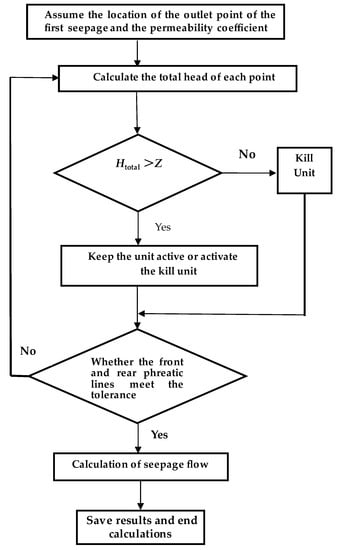
Figure 1.
Proposed calculation model for Seepage.
According to the above process, it is necessary to assume the outlet point position of the phreatic line, and use single-element birth and death technology to continuously “kill” the elements above the phreatic line; only the parts below the phreatic line participate in the calculation. It is always in the “live” state and continues to circulate until the tolerance is met.
According to the above ideas, the command flow for seepage analysis and calculation is prepared and verified by a practical example: assume that the dam height of the homogeneous earth dam under study is 20 m, the dam crest is 6 m wide, the bottom is 80 m wide, the upstream slope ratio is 1:1.5, and the downstream slope ratio is 1:2.2. The working condition is that the upstream water depth is 18 m, and the downstream water is free. See Table 1 for the relationship between the void pressure value and the permeability coefficient index.

Table 1.
Table of Relationship between Void Pressure Value and Permeability Coefficient Index.
Homogeneous dam refers to a dam that is composed of most of the dam body filled with homogeneous soil materials. The whole dam body of the homogeneous dam (except for the drainage facilities) is made of soil with low permeability. The pore water pressure dissipates slowly during the construction period, which is unfavorable to the settlement and stability of the dam body during the dam construction. Therefore, it is not suitable to use fat clay with a high clay content.
The reason for choosing the above homogeneous earth dam is that a consistent conclusion has been reached for the water conservancy project. Therefore, the basic realization could be used for justification of calculation results.
The relationship between void pressure and permeability coefficient, Table 1, can be used to qualitatively and quantitatively analyze the saturation of soil, which is of certain significance for macroscopic understanding of soil rock seepage. The finite element model of the homogeneous dam is built, which has 3312 elements and 3436 nodes. The calculation results are shown in Figure 2.
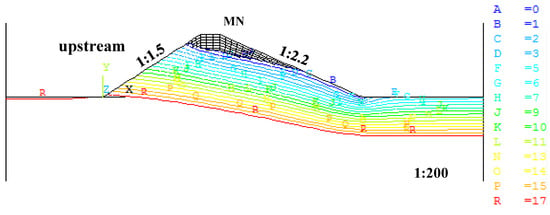
Figure 2.
Calculation result for seepage.
In Figure 3, the pressure head is zero, starting at the upstream water level of 18 m, and the flow line flowing out at the downstream slope nodes of 583, 584, 585, 586, 587, 588, 589, 590, 591, and 545 is called the phreatic line. The left end of this line marks the zero-water pressure point. The seepage calculation, analysis, and evaluation mainly depend on the pressure head in Figure 2. As the three very important factors of seepage, the range, trend, and saturation could be obtained based on Figure 2. Line A in Figure 2 is called the phreatic line. See Figure 3 for the total seepage flow and escape node numbers. The total seepage flow is 87,090 m3/d. Based on the basic seepage theory of the earth-rock dam, the dam is divided into multiple areas by a phreatic line for a homogeneous earth dam. The two endpoints of the phreatic line are the dividing points. Divided areas are consisted of upstream wedge, middle section and downstream wedge. The overall seepage state of the homogeneous dam is consistent with our calculation results. Therefore, according to the basic seepage theory of an earth-rock dam, the calculated results are reasonable and can be used to analyze the actual project.
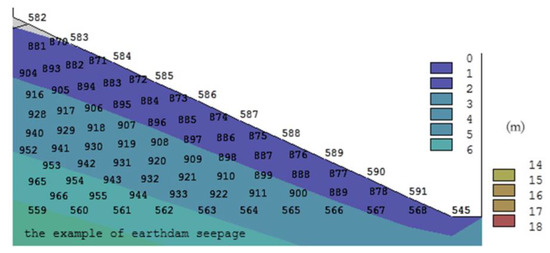
Figure 3.
Downstream slope nodes.
2. Calculation
Finite Element Model
In order to study the dangerous CCDDCR behavior, a typical earth-rock dam is selected. The catchment area of the dam is 23.4 km2, and the valley is a wide “U” type, whose bottom width is about 60 m. The bottom elevation of the valley is 86 m. The reservoir area is located in the middle and low mountain areas, which are composed of gneisses and pyroclastic rocks. The normal pool level is 122.50 m. Based on the data of drilling and test, the dam is a clay core wall sand shell dam, with a height of 38.5 m. The crest elevation of the dam is 126.20 m, its crest length is 210.0 m, and the width of the dam is 5.0 m. The maximum width of the dam is 184.01 m. The parapet wall crest elevation, which is upstream, is 127.30 m. The materials division is shown as follows: the outer layer is sand gravel stratum, layer I; The maximum thickness is 9.85 m, distributed in the upstream and downstream surface of the dam; The middle is mud gravel soil clay (sandy loam) layer, layerII3; The inner core is layer II2 and maximum thickness of it is 41.40 m; Layer III foundation contains mud, sand, eggs, and gravel soil, with a thickness of 2.6 m to 5.0 m, mainly distributed in 85.0~90.0 m elevation; Layer IV is for concrete cutoff wall with the thickness of 0.8 m. The model is using holistic modeling, and the mesh model of separated forms 28,407 solid elements in total. The model is shown in Figure 4, Figure 5, Figure 6 and Figure 7.
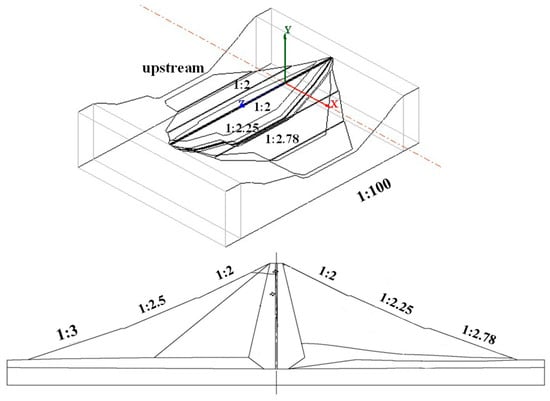
Figure 4.
Main dam body and the dam x-section.

Figure 5.
3D solid model of dam.
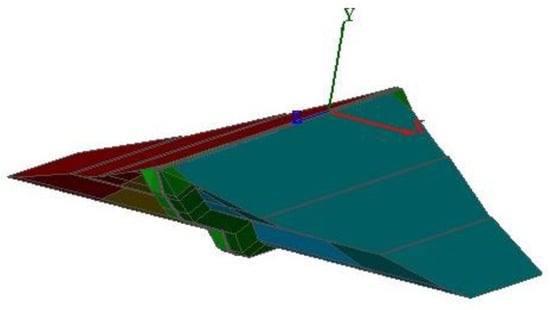
Figure 6.
3D solid model of dam body without bedrock.
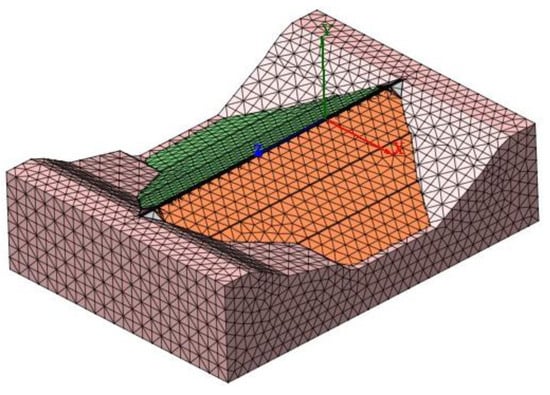
Figure 7.
3D finite element model of dam.
The mesh model is discretized into 29,523 solid elements with different material properties. The area and meshes of this model are divided from top to bottom, front to back, and inside to outside according to the dam foundation, front, back, cutoff-wall, and other parts.
3. Seepage Analysis
For the three-dimensional finite element model, the characteristics of the different materials are listed in Table 2.

Table 2.
Characteristics of the materials for the main dam.
The phenomenon of water flowing into soil pores is called seepage. The existing states of water in soil include gaseous water, adherent water, membrane water, capillary water, and gravity water, of which gravity water is the object of seepage theory research.
Seepage mainly refers to the flow of fluid in porous media. For groundwater, the flow of water in pores and fractures is a specific seepage example. The space area occupied by seepage flow is called the seepage field. Seepage is divided into saturated seepage and unsaturated seepage; seepage can be divided into stable seepage and unstable seepage according to whether the water head, hydraulic gradient, and other indicators change with time. Saturated seepage refers to seepage in a saturated zone, and seepage in an unsaturated zone is called unsaturated seepage. As long as one of these characterization parameters changes with time, it is called unstable seepage. Equation (10) is used for stable seepage, while Equation (11) is for unstable seepage. On the contrary, when each basic element is independent of the time factor in the seepage process, it is called stable seepage. In the earth rock dam project, seepage mainly refers to the flow of water in the soil pores, but the size and shape of the soil pores are very irregular, so the flow of water in the soil pores is a very complex phenomenon.
The calculation was completed based on the above-proposed method. A checking water level of 125.12 m was chosen. The water pressure at the upstream surface of the dam was defined as a certain value, and that at the downstream surface was taken as zero. The base of the dam and the downstream surface were considered permeable boundaries. Dam foundation seepage is a typical form. A certain thickness of the permeable base of the dam was considered to truly reflect the actual project. The seepage results were also embodied at the base of the dam in Figure 8 and Figure 9.

Figure 8.
Isograms of pressure head for the main dam though the common method.

Figure 9.
Isograms of equipotential line for the main dam using the common method.
From the result shown in Figure 10 and Figure 11, the maximum penetration ratio of the gravel is 0.12 (the allowed penetration is 0.15), the maximum penetration ratio of the dam core wall is 0.38 (the allowable penetration is 0.4) [24], the maximum penetration ratio of the cut-off wall is 16.2 (the allowed penetration ratio is 50); these were all less than the allowable penetration of the dam. Based on the above conclusion, there will not be seepage failure. The single wide seepage flow of the main dam is 0.52 m3/(m·d), which belongs to a small flow. The arrow of the velocity vector at the right side upper layer of the dam existed for direction guidance for the combing of vertical and horizontal water pressure for Figure 12.
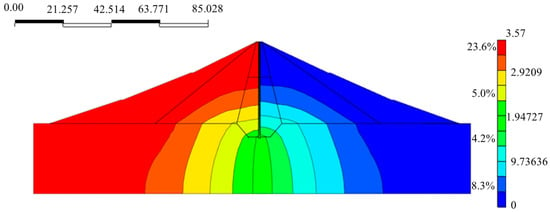
Figure 10.
Isograms of pressure head for the main dam by the proposed method.
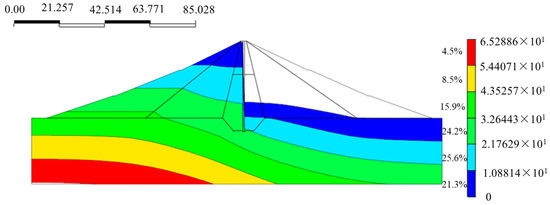
Figure 11.
Seepage pressure contour map of the checking flood level by the proposed method.
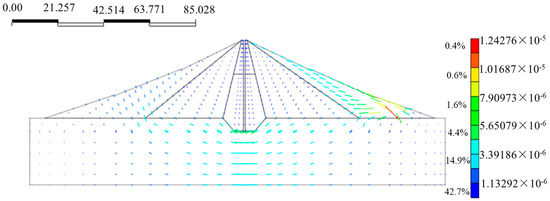
Figure 12.
Velocity vector diagram of the checking flood level by the proposed method.
4. Stability Analysis
In this program example, finite element analysis of slope stability is calculated by choosing upstream that designs the flood level which is 124.33 m and checks flood level which is 125.12 m. The bottom of the dam foundation and the left and right sides are fixed boundaries, and the dam surface is a free boundary. Calculation parameters are shown in Table 2. Calculation results are added to other conditions (seepage results of pore water pressure). Comparative results are shown in Table 3.

Table 3.
Material properties indicators of main dam.
Figure 13 and Table 4 show that: (1) for the calculation of “design flood level” and “check flood level” by Li Zheng software, the safety factor does not change. So the calculation of the Li Zheng software is not sensitive when the water level does not change significantly. However, FEM software analysis results are more reasonable; (2) considering the osmotic pressure, the calculation result of Li Zheng software is less than that of the FEM software, probably due to the fact that the Li Zheng calculation is based on the conventional limit equilibrium method, which only considers the structure gravity without considering the impact of the dam stress. The stress on the dam is mostly compressive stress, which has a positive effect on the stability of the slope. So the safety factor based on the finite element analysis of FEM software is larger; (3) through the same software, comparing considering seepage with not considering seepage, the osmotic pressure shows a greater impact in the calculation results in the calculation of sliding stable safety factor and the presence of osmotic pressure reduces safety factor; (4) by calculating the results calculated with the FEM and Li Zheng, it is concluded that the FEM is reliable while the Li Zheng, used widely in practical engineering, is considered to be the basic and original reference. (5) finite element analysis of slope stability does not need to make assumptions to part of the internal forces and the shape of slip surface, which makes the analysis research results of theoretical basis even tighter; and (6) the applications scheme of reinforcement is safe and reliable.

Figure 13.
The Maximum shear strain diagrams.

Table 4.
Contrast Table of safety factor F.
5. The Influence of Elastic Modulus to Concrete Diaphragm Wall
For the reason the diaphragm wall is located in the clay core wall of the original dam, the maximum depth is 41.80 m. When the conventional concrete is used and wall elastic modulus is higher, large deformation and stress concentration will occur under the water load. The tensile stress generated the wall cracks. Thereby it affects seepage effect. Due to the importance of low elastic modulus concrete in similar reinforcement projects, and the cutoff wall of this project subjects to change in the elastic modulus, so it is focused for different elastic modulus impacts on the cutoff wall for calculation and analysis. The analysis results are given as a reference for similar reinforcement projects. Parameters required for finite element calculation are adopted from similar projects at home and abroad. Similar material nonlinear stress-strain parameters use the Duncan-Chang nonlinear constitutive model with a total of eight model parameters, which can be determined by a conventional triaxial specimen. Dam and foundation material parameter values are selected based on geological drilling data. The calculation of material parameters is listed in Table 5.

Table 5.
The material parameter table of main dam.
The result is analyzed by comparing the SDAP software from the China Institute of Water Resources and Hydropower Research with FEM software under the case of check flood level, as shown in Table 6.

Table 6.
Stress and strain calculation results table under different elastic modulus for main dam.
From SDAP software calculation results, the maximum tensile stress in the diaphragm wall is 0.92 MPa with the elastic modulus of 2500 MPa, respectively, while the maximum tensile stress in the diaphragm wall is 2.01 MPa with the elastic modulus of 5000 MPa, and it appears around 83.70 m elevation. In CCDDCR, the cutoff wall stress changes with the elastic modulus. When the elastic modulus is greater than 3000 MPa, the stress variation in the cutoff wall is significant. For this reason, less than 3000 MPa of elastic modulus is suggested. From Figure 8, Figure 9, Figure 10, Figure 11 and Figure 12, it can be seen that the effect of a concrete anti-seepage wall with low-elastic-modulus material on seepage prevention in a reinforced earth–rock dam is clear. It can be concluded that this type of concrete material is appropriate for reducing seepage during the process of reinforcement.
Different analysis keys exist for different dam types. For the concrete dam, the deformation or stress is the key content, while the seepage is the most important factor for the earth-rock dam. Therefore, the seepage analysis is carried out in this paper. The seepage analysis also reflects the deformation and stress of the concrete wall. A large amount of seepage indicates a large area of deformation or stress.
There are many factors influencing the stability of earth-rock dams, including the structures made of soils and the concrete ones. For the structures of soils, the permeability coefficient is the most important factor, while the elastic modulus is the key for concrete structures. The cut-off wall composed of concrete is the research object of this paper. Therefore, the seepage situation of the earth-rock dam is analyzed based on the elastic modulus of the cut-off wall.
6. Conclusions
Based on the research on the dangerous CCDDCR behavior, a typical example is selected as the research object. A seepage calculation method by FEM was proposed, and a 3-D nonlinear finite element model was developed. Based on FEM software, the SDAP program, and Li Zheng software, the seepage, stability, and other reinforcement behaviors are evaluated and analyzed, allowing for more reasonable conclusions. The proposed FEM method is validated for a good application to handle the dangerous CCDDCR. The research is based on the diaphragm wall material’s low elastic modulus of concrete. Through a multi-group analysis, the influence law of the low elastic modulus of concrete materials on the cutoff wall is obtained to give reference to similar reinforcement projects.
Author Contributions
Conceptualization, M.Y. and C.G.; methodology, D.W.; software, D.W.; validation, M.Y.; formal analysis, M.Y.; investigation, D.W.; resources, D.W.; data curation, D.W.; writing—original draft preparation, M.Y., D.W.; writing—review and editing, M.Y. All authors have read and agreed to the published version of the manuscript.
Funding
This work was supported by the China Postdoctoral Science Foundation (Grant No. 2022M721668, 2021M701044), Open Fund of Research Center on Levee Safety Disaster Prevention of Ministry of Water Resources under Grant (LSDP202204), Science and technology projects managed by the headquarter of State Grid Corporation (5108-202218280A-2-417-XG), the National Natural Science Foundation of China (51739008, 52239009, 52209159, U2243223, 51739003, 51909173, 51739003); Open fund of National Dam Safety Research Center (Grant No. CX2020B02); Fundamental Research Funds for Central Public Welfare Research Institutes (Research on key technologies for ensuring and improving the effectiveness of new polarization-maintaining optical fiber distributed monitoring in water engineering, Project leader: Meng Yang, Nanjing Hydraulic Research Institute). Open Foundation of State Key Laboratory of Hydrology-Water Resources and Hydraulic Engineering (Grant No. 520003812), Fundamental Research Funds for the Central Universities (Grant No. 2019B69814).
Institutional Review Board Statement
Not applicable.
Informed Consent Statement
Not applicable.
Data Availability Statement
Not applicable.
Conflicts of Interest
The authors declare no conflict of interest.
References
- Altunisik, A.C.; Sesli, H. Dynamic response of concrete gravity dams using different water modelling approaches: Westergaard, lagrange and euler. Comput. Concr. 2015, 16, 429–448. [Google Scholar] [CrossRef]
- Zhong, D.; Sun, Y.; Li, M. Dam break threshold value and risk probability assessment for an earth dam. Nat. Hazards 2011, 59, 129–147. [Google Scholar] [CrossRef]
- Khazaee, A.; Lotfi, V. Time harmonic analysis of dam-foundation systems by perfectly matched layers. Struct. Eng. Mech. 2014, 50, 349–364. [Google Scholar] [CrossRef]
- Le, T.M.H.; Gallipoli, D.; Sanchez, M.; Wheeler, S.J. Stochastic analysis of unsaturated seepage through randomly heterogeneous earth embankments. Int. J. Numer. Anal. Methods Géoméch. 2012, 36, 1056–1076. [Google Scholar] [CrossRef]
- Ni, Y.; Xia, Y.; Lin, W.; Chen, W.; Ko, J. SHM benchmark for high-rise structures: A reduced-order finite element model and field measurement data. Smart Struct. Syst. 2012, 10, 411–426. [Google Scholar] [CrossRef]
- Li, X.; Ni, Y.-Q.; Wong, K.; Chan, K. Structural health rating (SHR)-oriented 3D multi-scale finite element modeling and analysis of Stonecutters Bridge. Smart Struct. Syst. 2015, 15, 99–117. [Google Scholar] [CrossRef]
- Sevim, B.; Altunisik, A.C.; Bayraktar, A. Construction stages analyses using time dependent material properties of concrete arch dams. Comput. Concr. 2014, 14, 599–612. [Google Scholar] [CrossRef]
- Zhu, H.-H.; Yin, J.-H.; Dong, J.-H.; Zhang, L. Physical modelling of sliding failure of concrete gravity dam under overloading condition. Géoméch. Eng. 2010, 2, 89–106. [Google Scholar] [CrossRef]
- Liu, Y.; Wang, M.Y.; Pan, Y.; Yao, K. Large-Scale 3D Random Finite Element Analysis of Embankment Seepage Stability. In Advancements in Geotechnical Engineering, Proceedings of the 6th GeoChina International Conference on Civil & Transportation Infrastructures: From Engineering to Smart & Green Life Cycle Solutions, Nanchang, China, 19–21 July 2021; Springer: Berlin/Heidelberg, Germany, 2021; pp. 1–13. [Google Scholar]
- Wang, R.-H.; Li, D.-Q.; Wang, M.-Y.; Liu, Y. Deterministic and Probabilistic Investigations of Piping Occurrence during Tunneling through Spatially Variable Soils. ASCE-ASME J. Risk Uncertain. Eng. Syst. Part A Civ. Eng. 2021, 7, 04021009. [Google Scholar] [CrossRef]
- Bullen, T.D.; Wang, Y. Dam foundation water quality and seepage as a result of water-rock interaction. Water-Rock Interact. 2007, 1–2, 1691–1694. [Google Scholar]
- Mazars, J.; Grange, S. Modeling of reinforced concrete structural members for engineering purposes. Comput. Concr. 2015, 16, 683–701. [Google Scholar] [CrossRef]
- Su, H.; Wen, Z.; Wang, F. Fractal behavior identification for monitoring data of dam safety. Struct. Eng. Mech. 2016, 57, 529–541. [Google Scholar] [CrossRef]
- Yu, Y.; Xie, L.; Zhang, B. Stability of earth–rockfill dams: Influence of geometry on the three-dimensional effect. Comput. Geotech. 2005, 32, 326–339. [Google Scholar] [CrossRef]
- Tang, D.; Gordan, B.; Koopialipoor, M.; Armaghani, D.J.; Tarinejad, R.; Pham, B.T.; Van Huynh, V. Seepage Analysis in Short Embankments Using Developing a Metaheuristic Method Based on Governing Equations. Appl. Sci. 2020, 10, 1761. [Google Scholar] [CrossRef]
- Gazdzicki, M.; Gorenstein, M. Transparency, mixing and reflection of initial flows in relativistic nuclear collisions. Phys. Lett. B 2006, 640, 155–161. [Google Scholar] [CrossRef]
- Desai, B.; Lenka, S. Quantification of blast furnace hearth drainage parameters through physical model study. Ironmak. Steelmak. 2007, 34, 269–271. [Google Scholar] [CrossRef]
- Zhao, J.; Zhang, B.; Mao, S.; Chen, S. The Divergence-Free Nonconforming Virtual Element for the Stokes Problem. SIAM J. Numer. Anal. 2019, 57, 2730–2759. [Google Scholar] [CrossRef]
- Li, X. Modified initial flow method for FEM analysis of unconfined seepage. J. Hydraul. Eng. 2007, 38, 961–965. [Google Scholar]
- Chen, H.; Zheng, P.; Sun, X.; Xiao, J.; Zhu, T.; Sun, J.; Zhu, J.; Li, Z.; Cao, Y.; Yan, J. Characterize the grid inefficiency correction of Frisch grid ionization chamber with Garfield and SRIM. J. Instrum. 2022, 17, P03023. [Google Scholar] [CrossRef]
- Fu, Y.; Zhou, Z.; Wu, Y. Improved adjustment method of compound element conductivity matrix for calculating 3D seepage field with free surface. Chin. J. Geotech. Eng. 2009, 31, 1434–1439. [Google Scholar]
- Mascarenhas, P.V.S.; Cavalcante, A.L.B. Stochastic Foundation to Solving Transient Unsaturated Flow Problems Using a Fractional Dispersion Term. Int. J. Géoméch. 2022, 22, 04021262. [Google Scholar] [CrossRef]
- Huang, P.; Zhang, Y. Analysis of seepage characteristics of mine fractures based on geothermal utilization. Bulg. Chem. Commun. 2017, 49, 44–48. [Google Scholar]
- Li, M.-Y.; Pan, J.; Niu, Y.-G. Sensitivity analysis of system wind penetration to thermal generation ramp rates. In Proceedings of the 2017 IEEE Manchester PowerTech, Manchester, UK, 18–22 June 2017; pp. 1–6. [Google Scholar] [CrossRef]
Disclaimer/Publisher’s Note: The statements, opinions and data contained in all publications are solely those of the individual author(s) and contributor(s) and not of MDPI and/or the editor(s). MDPI and/or the editor(s) disclaim responsibility for any injury to people or property resulting from any ideas, methods, instructions or products referred to in the content. |
© 2023 by the authors. Licensee MDPI, Basel, Switzerland. This article is an open access article distributed under the terms and conditions of the Creative Commons Attribution (CC BY) license (https://creativecommons.org/licenses/by/4.0/).